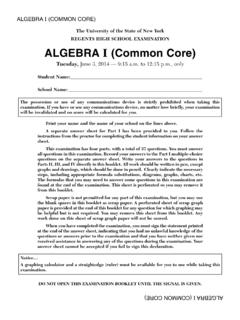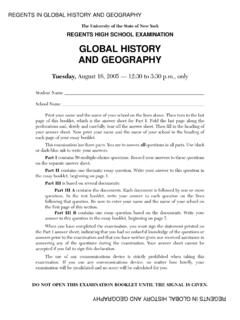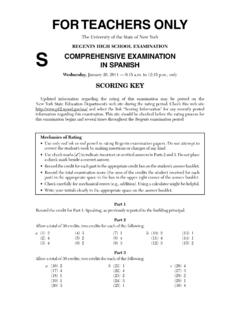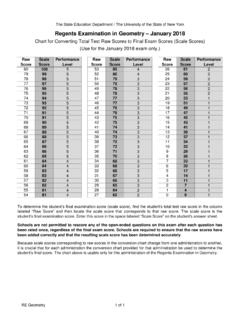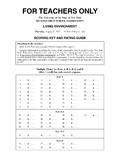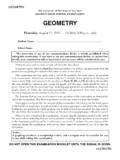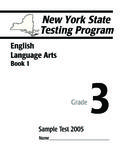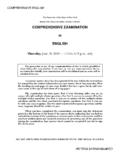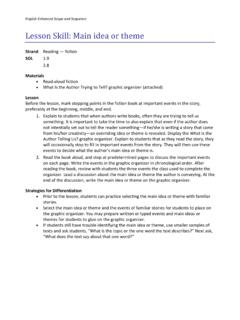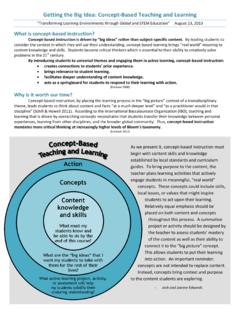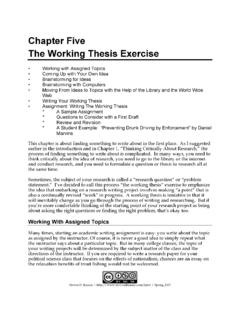Transcription of TRANSITION EXAM IN MC & THEMATIC GLOBAL HISTORY …
1 Copyright 2018 The University of the State of New YorkTHE STATE EDUCATION DEPARTMENTA lbany, New York 12234 VOLUME1OF2MC & THEMATICFOR TEACHERS ONLYThe University of the State of New YorkREGENTS HIGH SCHOOL EXAMINATIONTRANSITION EXAM INGLOBAL HISTORY AND GEOGRAPHY GRADE 10 Tuesday,June 5, 2018 9:15 to 12:15 , onlySCORING KEY FOR PART I AND RATING GUIDE FOR PART II ( THEMATIC ESSAY)Scoring the Part I Multiple-Choice QuestionsFollow the procedures set up by the Regional Information Center, the Large City Scanning Center,and/or the school district for scoring the multiple-choice questions. If the student s responses for themultiple-choice questions are being hand scored prior to being scanned, the scorer must becareful not to make any marks on the answer sheet except to record the scores in the designatedscore boxes. Any other marks on the answer sheet will interfere with the accuracy of Choice for Part IAllow 1 credit for each correct.
2 1.. 2 .. 3.. 3 .. 2.. 4 .. 1.. 5 .. 3.. 6 .. 2.. 7 .. 4.. 8 .. 2.. 9 .. 2.. 10 .. 4.. 11 .. 1.. 12 .. 3.. 13 .. 1.. 14 .. 1.. 15 .. 2.. 16 .. 4.. 17 .. 1.. 18 .. 1.. 19 .. 3.. 20 .. 1.. 21 .. 4.. 22 .. 4.. 23 .. 2.. 24 .. 4.. 25 .. 1.. 26 .. 3.. 27 .. 4.. 28 .. 3.. 29 .. 3.. 30 .. 4.. Updated information regarding the rating of this examination may be posted on the New York State Education Department s web site during the rating period. Visit the site at: select the link Scoring Information for any recently postedinformation regarding this examination. This site should be checked before the rating process for thisexamination begins and several times throughout the Regents Examination IGlobal Hist.
3 & Geo. Rating Guide June 18[2]Vol. 1 Contents of the Rating GuideForPart I(Multiple-Choice Questions): Scoring KeyForPart II( THEMATIC ) essay: A content-specific rubric Prescored answer papers. Score levels 5 and 1 have two papers each, and score levels 4, 3, and 2 havethree papers each. They are ordered by score level from high to low. Commentary explaining the specific score awarded to each paper Five prescored practice papersGeneral: Test Specifications Web addresses for the test-specific conversion chart and teacher evaluation formsMechanics of RatingThe following procedures are to be used in rating essay papers for this examination. More detailed directions for the organization of the rating process and procedures for rating the examination are includedin the Information Booklet for Scoring the TRANSITION Regents Examination in GLOBAL HISTORY andGeography Grade the Essay Question(1) Follow your school s procedures for training raters.
4 This process should include:Introduction to the task Raters read the task Raters identify the answers to the task Raters discuss possible answers and summarize expectations for student responsesIntroduction to the rubric and anchor papers Trainer leads review of specific rubric with reference to the task Trainer reviews procedures for assigning holistic scores, , by matching evidence from the responseto the rubric Trainer leads review of each anchor paper and commentaryPractice scoring individually Raters score a set of five papers independently without looking at the scores and commentaries provided Trainer records scores and leads discussion until the raters feel confident enough to move on toactual rating(2) When actual rating begins, each rater should record his or her individual rating for a student s essay onthe rating sheet provided, not directly on the student s essay or answer sheet.
5 The rater should not correct the student s work by making insertions or changes of any kind.(3) Each essay must be rated by at least two raters; a third rater will be necessary to resolve scores that differ by more than one are not permitted to rescore any of the open-ended questions (scaffold questions, THEMATIC essay, DBQ essay) on this exam after each question has been rated the required number of times as specified in the rating guides, regardless of the final exam score. Schools arerequired to ensure that the raw scores have been added correctly and that the resulting scale scorehas been determined accurately. Teachers may not score their own students answer Hist. & Geo. Rating Guide June 18[3]Vol. 1 TRANSITION Exam in GLOBAL HISTORY and Geography Grade 10 Content-Specific Rubric THEMATIC Essay June 2018 Scoring Notes: 1. This THEMATIC essay has six components (discussing the historical circumstances surrounding the writing associated with each of two different intellectuals, philosophers, and/or leaders, a main idea found in each writing, and how each idea influenced the development of a nation or region).
6 2. For each written work, the main idea described should be used in discussing the influence of that idea on the development of a nation or region. 3. A nation or region does not need to be specifically identified as long as it is implied in the discussion. 4. The same nation or region may have been influenced by the ideas of different intellectuals, philosophers, and leaders, , both John Locke and Adam Smith had an influence on Great Britain and/or on Europe. 5. As is the case with many historical topics, what constitutes an influence on a nation or region may be discussed from a variety of perspectives as long as the position taken is supported with accurate historical facts and examples. 6. If more than two written works are discussed, only the first two may be scored. 7. The response may include treatment of a topic drawn from the ninth-grade curriculum as long as the response meets the requirements of the task, , Martin Luther Ninety-five Theses.
7 8. While the intellectual, philosopher, or leader may not be the writer of a particular work, the writing paired with an individual must represent that person s ideas , , Confucius and the Analects. Theme: Culture and Intellectual Life Intellectuals, philosophers, and leaders have often recorded their ideas in written works. These ideas have been used throughout HISTORY to guide societies and influence the course of national and regional development. Task: Select two intellectuals, philosophers, and/or leaders and a writing associated with that person and for each Describe the historical circumstances surrounding this writing Describe a main idea found in this writing Discuss how this idea has influenced the development of a nation or region You may use any intellectuals, philosophers, or leaders from your study of GLOBAL HISTORY and geography. Some suggestions you might wish to consider include: John Locke Two Treatises on Government Adam Smith Wealth of Nations Olympe de Gouges The Declaration of the Rights of Woman Karl Marx Communist Manifesto Theodor Herzl On the Jewish State Adolf Hitler Mein Kampf Elie Wiesel Night Mao Zedong Little Red Book Nelson Mandela Long Walk to Freedom You are not limited to these suggestions.
8 Do not use any intellectual, philosopher, or leader from the United States in your answer. GLOBAL Hist. & Geo. Rating Guide June 18[4]Vol. 1 Score of 5: Thoroughly develops all aspects of the task evenly and in depth by discussing the historical circumstances surrounding the writing associated with each of two different intellectuals, philosophers, and/or leaders, a main idea found in each writing, and how each idea has influenced the development of a nation or region Is more analytical than descriptive (analyzes, evaluates, and/or creates* information) , Karl Marx Communist Manifesto: connects the abuses of the Industrial Revolution in the factory system, Marx s development of the concept of scientific socialism, and Marx s analysis of private property to the idea of inevitable victory by the proletariat in a class war and the adaptation of Marxism by Lenin and Stalin in the Soviet Union; Mao Zedong Little Red Book: connects Mao s desire to revitalize the communist revolution and remove those promoting the old ways to the promotion of a cult of personality, the elevation of Mao s views on power, the empowering of the Red Guards, the purging of capitalist roaders, and chaos Richly supports the theme with relevant facts, examples, and details, , Karl Marx Communist Manifesto: capitalism; Friedrich Engels; utopian socialism; class struggle; Das Kapital; Communist International; five-year plans; Mao Zedong Little Red Book: Cultural Revolution; the four olds; reeducation camps; battle against traditional culture and the party establishment; book burnings; destruction of Western objects and Chinese temples; brutality against teachers and bureaucrats Demonstrates a logical and clear plan of organization.
9 Includes an introduction and a conclusion that are beyond a restatement of the theme Score of 4: Develops all aspects of the task but may do so somewhat unevenly by discussing one individual s writing more thoroughly than the other individual s writing or by discussing one aspect of the task less thoroughly than the other aspects of the task Is both descriptive and analytical (applies, analyzes, evaluates, and/or creates* information), , Karl Marx Communist Manifesto: discusses how abuses during the Industrial Revolution contributed to the development of Marx s ideas , how the idea of redistributing property appealed to industrial workers, and how Lenin claimed he was implementing Marx s ideas in Russia; Mao Zedong Little Red Book: discusses how Mao s concerns about the health of the Communist Party was tied to the Cultural Revolution, how Mao s sayings about power and the Party promoted a cult of personality, and how China suffered a period of purging and chaos Supports the theme with relevant facts, examples, and details Demonstrates a logical and clear plan of organization; includes an introduction and a conclusion that are beyond a restatement of the theme Score of 3: Develops all aspects of the task with little depth or develops at least four aspects of the task in some depth Is more descriptive than analytical (applies, may analyze and/or evaluate information) Includes some relevant facts, examples, and details; may include some minor inaccuracies Demonstrates a satisfactory plan of organization.
10 Includes an introduction and a conclusion that may be a restatement of the theme Note: If all aspects of the task have been thoroughly developed evenly and in depth for one written work associated with an individual and if the response meets most of the other Level 5 criteria, the overall response may be a Level 3 paper. GLOBAL Hist. & Geo. Rating Guide June 18[5]Vol. 1 Score of 2: Minimally develops all aspects of the task or develops at least three aspects of the task in some depth Is primarily descriptive; may include faulty, weak, or isolated application or analysis Includes few relevant facts, examples, and details; may include some inaccuracies Demonstrates a general plan of organization; may lack focus; may contain digressions; may not clearly identify which aspect of the task is being addressed; may lack an introduction and/or a conclusion Score of 1: Minimally develops some aspects of the task Is descriptive; may lack understanding, application, or analysis Includes few relevant facts, examples, or details; may include inaccuracies May demonstrate a weakness in organization; may lack focus; may contain digressions; may not clearly identify which aspect of the task is being addressed.

